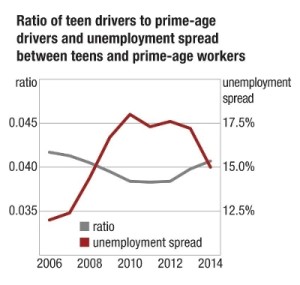 Teenage drivers are returning to the roads, according to an analysis by the Highway Loss Data Institute (HLDI), an affiliate of the Insurance Institute for Highway Safety. Researchers link the trend to the recent economic recovery.
Teenage drivers are returning to the roads, according to an analysis by the Highway Loss Data Institute (HLDI), an affiliate of the Insurance Institute for Highway Safety. Researchers link the trend to the recent economic recovery.
Teenagers have the highest crash rate per mile traveled of any drivers, so the number of young people on the roads has important safety consequences.
Teen driving began to decline sharply about a decade ago. While many observers speculated that the proliferation of cellphones and social media had made driving less attractive to teenagers, HLDI showed there was a strong relationship between the decline in teen driving and rising teen unemployment (see “Drop in teen driving tracks with teenage unemployment,” Nov. 7, 2013).
In a reversal, from 2012 to 2014, more teenagers found jobs. At the same time, more teenagers began driving, an update to the HLDI study shows.
“It seems like many teens really do want to drive after all, and much of the earlier decline in driving was due to the disproportionate effect of the economy on teen employment,” HLDI Vice President Matt Moore says. “When teenagers have jobs, they have more of a need to drive, along with money to help pay for it.”
For the 2013 study and the current update, HLDI analysts looked at changes in the number of rated drivers 19 and younger under collision insurance policies in 49 states and the District of Columbia. A rated driver on a policy is typically the driver in the household considered to represent the greatest loss potential for the insured vehicle (usually the teen driver if there is one).
From 2006 to 2012, the number of rated drivers 19 and younger fell. The number of rated drivers ages 35-54, referred to in the study as prime-age drivers, also dropped, but not as sharply. The result was fewer teen drivers relative to prime-age drivers.
During 2013 and 2014, teen exposure went back up, while prime-age exposure continued to decline slightly.
Expressing the change as a ratio of teen drivers to prime-age drivers controls for factors that aren’t specific to teenagers. The ratio of teen drivers to prime-age drivers fell from 0.042 in 2006 to 0.038 in 2010 and then remained relatively constant through 2012. The ratio increased to 0.041 in 2014 as teens returned to the roads.
Meanwhile, the unemployment rate, defined as the percentage of the total labor force that is unemployed and actively seeking work, increased for both groups between 2006 and 2010, but the rise was steeper for teens. During 2013-14, the unemployment rate for both groups fell, with teens experiencing a sharper decrease.
Thus, the unemployment spread — the difference in unemployment rates for the two groups — increased during the height of the recession, leveled off after 2010 and declined in the past few years.
Looked at together, there is an inverse relationship between the unemployment spread and the ratio of teen drivers to prime-age drivers.
Although population changes and changes in state licensing ages contributed somewhat to changes in the teen driver ratio, HLDI estimates that 67 percent of the ratio’s increase between 2012 and 2014 is connected with the decreasing unemployment spread.
Source: Insurance Institute for Highway Safety
Search TeenAuto
Socialize with Us
Like us on FacebookFollow us on TwitterWatch our Channel